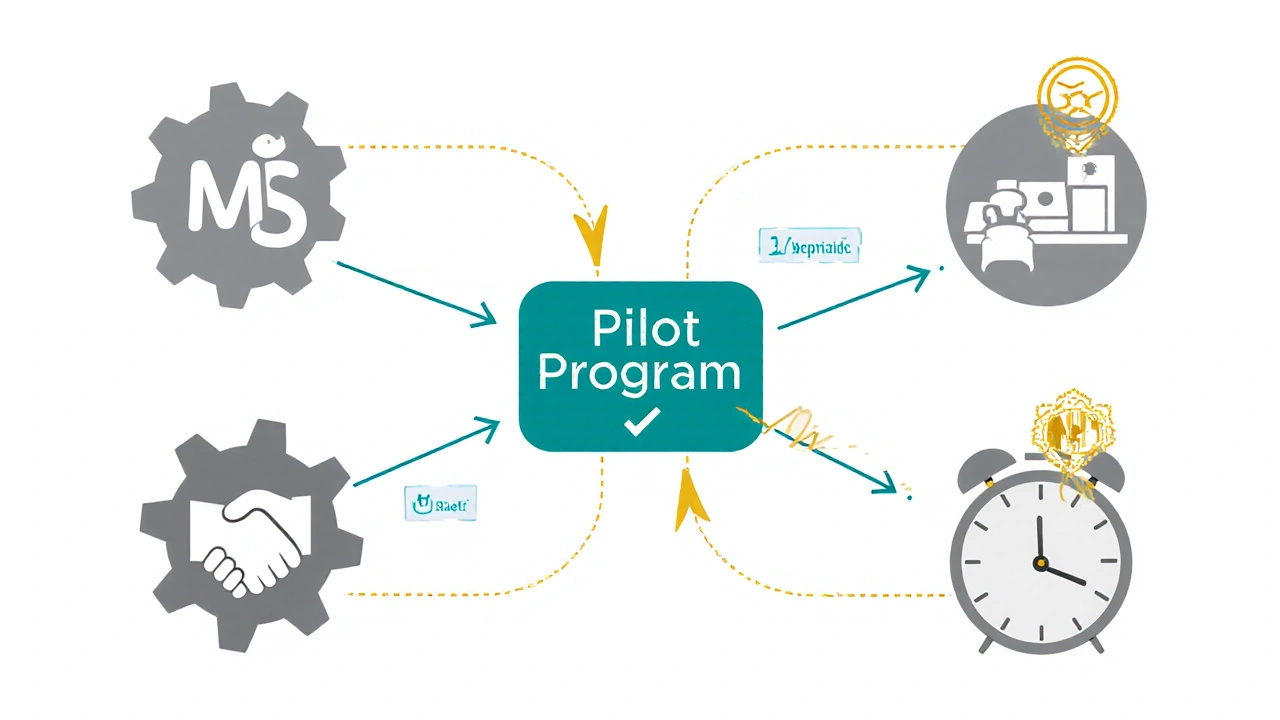Choosing the right Learning Management System (LMS) isn’t about picking the one with the flashiest interface or the loudest sales pitch. It’s about finding the platform that actually works for your teachers, students, and daily workflows. That’s why running a pilot program is the smartest move before you commit to a big purchase. A pilot lets you test-drive an LMS in the real world-before you spend thousands, retrain staff, or disrupt learning.
Start with clear goals, not features
Don’t begin by listing features you want. Start by asking: What problems are we trying to solve?Is your current LMS too hard for teachers to update content? Are students dropping out because the platform is confusing? Is grading taking too long? Maybe your staff can’t track progress across courses. Write down three to five real, measurable issues. These become your success metrics.
For example:
- Reduce time teachers spend uploading assignments by 40%
- Increase student logins per week from 3 to 5
- Cut help desk tickets about login issues by 50%
These aren’t vague hopes-they’re benchmarks you’ll measure at the end. If your pilot doesn’t move the needle on these, the platform isn’t worth it.
Choose 2-3 platforms to test
You don’t need to test every LMS on the market. Focus on the top three that match your needs based on research, peer reviews, or vendor demos. Avoid choosing based on price alone. A cheap LMS that breaks during finals week costs more in lost time than a slightly pricier one that just works.Look at platforms like Moodle, Canvas, Google Classroom, Blackboard, or LearnDash. Each has strengths:
- Moodle is open-source and deeply customizable but needs tech support.
- Canvas is user-friendly and integrates well with tools like Zoom and Turnitin.
- Google Classroom is simple and free if you’re already using G Suite.
- Blackboard is common in higher ed but often clunky for new users.
Don’t pick based on what another school uses. Pick based on what your team needs. If most of your teachers are over 50 and not tech-savvy, a platform with drag-and-drop course building will beat one with 20 menus.
Recruit a small, diverse pilot group
Your pilot shouldn’t include everyone. Pick 10-15 teachers across subjects, experience levels, and tech comfort. Include at least one teacher who hates tech, one who’s a power user, and someone who’s retiring next year. You need honest feedback from all types.Also include 30-50 students. Not the top performers-the ones who struggle to log in, forget passwords, or drop off after the first week. Their experience tells you more than the A+ students.
Give them clear roles: “You’re testing assignment submission. You’re testing mobile access. You’re testing parent access.” Don’t just say, “Try it out and tell us what you think.” That leads to vague answers like “It’s okay.”

Run the pilot for 4-6 weeks
A pilot that lasts less than a month won’t show real usage patterns. Students forget passwords. Teachers forget to update grades. Systems crash during exams. You need time to see these things.Set a start and end date. Don’t extend it unless something major breaks. A six-week window is enough to spot trends. Use the first week for setup and training. Weeks 2-5 for real use. Week 6 for feedback and data collection.
Make sure each teacher has a backup plan. If the LMS goes down during grading, they should be able to use a simple spreadsheet or paper form. No one should feel stuck because the system failed.
Collect data, not opinions
Surveys are useful, but they’re not enough. You need hard numbers.Track:
- How many logins per user per week
- How long it takes to create a new assignment
- How many help tickets are raised
- Completion rates for quizzes and assignments
- Mobile vs. desktop usage
Use built-in analytics if the LMS has them. If not, ask your IT team to pull basic usage logs. You can even use a simple Google Form to ask teachers: “On a scale of 1-5, how easy was it to upload this week’s quiz?”
Don’t rely on what people say they like. Watch what they do. If teachers keep using email to send assignments instead of the LMS, the platform isn’t working for them.
Test integration with other tools
No LMS works alone. It needs to talk to your video conferencing tool, student information system, grading software, or attendance tracker.During the pilot, test these connections:
- Can Zoom meetings auto-create in the LMS?
- Can grades from the LMS sync with your student database?
- Can students log in with their school email (Single Sign-On)?
- Does the LMS work with screen readers or translation tools?
If the LMS can’t connect to tools you already use, you’ll end up with two systems to manage. That’s a nightmare for teachers and students.

Watch for hidden costs
The price tag on the vendor’s website isn’t the full cost. Look for:- Training time for staff (how many hours per teacher?)
- IT support needed for setup and fixes
- Cost of replacing old content (uploading 500 PDFs manually?)
- Annual fees for add-ons like plagiarism checkers or analytics
One school switched to a new LMS and didn’t realize the plagiarism checker cost $3,000 extra per year. They thought they were saving money-until they got the invoice.
Make a decision based on evidence
At the end of the pilot, gather your team. Don’t let the loudest voice win. Present the data:- Platform A: 85% of teachers reported faster grading, but 40% of students couldn’t access it on phones.
- Platform B: 90% login rate, but it took teachers 20 minutes longer to build a quiz.
- Platform C: Lowest support tickets, but no mobile app.
Match each platform’s performance to your original goals. Which one solved the most problems? Which one created new ones?
If no platform hits all your goals, go back to the drawing board. Don’t force a bad fit. A good LMS should make life easier, not harder.
Plan your rollout-then test it again
Once you pick a platform, don’t flip the switch on everyone at once. Roll it out in phases:- Month 1: Train 5 super-users
- Month 2: Launch to one department
- Month 3: Full rollout with ongoing feedback
Keep a feedback channel open. Set up a Slack channel or monthly meeting. People will find bugs you never saw. They’ll suggest features you didn’t think of. Listen.
The goal isn’t to pick the perfect LMS. It’s to pick the one that keeps improving with your team.
How long should a pilot program for an LMS last?
A pilot should last 4 to 6 weeks. This gives enough time to see how teachers and students use the system during real coursework, including assignment deadlines, exams, and parent communication cycles. Shorter pilots miss key usage patterns, while longer ones delay decision-making and increase disruption.
How many teachers and students should be in a pilot group?
Include 10-15 teachers across different subjects and tech comfort levels, and 30-50 students that represent the full range of users-high achievers, struggling students, and those who rarely log in. This ensures feedback covers all real-world scenarios.
Should we choose an LMS based on what other schools use?
No. Just because another school uses a platform doesn’t mean it fits your needs. Your staff’s tech skills, student demographics, and existing tools are unique. What works for a large university may overwhelm a small high school. Base your choice on your own pilot data, not peer pressure.
What if no LMS in the pilot meets our goals?
Go back and refine your goals. Maybe you’re asking for too much. Or maybe you need to adjust your expectations-like accepting that mobile access isn’t possible right now. You can also revisit vendors with your feedback. Some platforms will customize features if they see a real need.
Can we run a pilot without IT support?
It’s possible, but risky. Even simple LMS platforms need setup like Single Sign-On, user accounts, and data syncs. If you don’t have IT, work with the vendor’s onboarding team and assign one tech-savvy staff member to handle setup. Never skip testing integration with your student database or email system.
Is Google Classroom enough for a school?
Google Classroom works well for basic assignments and communication, especially if you’re already using G Suite. But it lacks advanced features like detailed analytics, robust grading tools, or course templates. If your school runs complex programs-like AP courses, special education, or dual enrollment-you’ll likely outgrow it within a year.


Comments
Adithya M
Man, I’ve seen so many schools waste months on LMS pilots because they didn’t set real metrics. You gotta track logins, assignment uploads, help tickets-otherwise you’re just collecting opinions dressed up as data. If teachers are still emailing PDFs, your ‘new’ platform is just a fancy paperweight.
Jessica McGirt
This is one of the clearest, most actionable guides I’ve read on LMS selection. The emphasis on measurable outcomes over flashy features is exactly what’s missing in edtech decisions. Kudos to the author for calling out the ‘Google Classroom is enough’ myth-it’s not, not for schools with real curriculum depth.
Donald Sullivan
Everyone’s talking about metrics like it’s some holy grail. Newsflash: teachers don’t care about your spreadsheets. They care if it works on their phone, if it doesn’t crash during finals, and if they can actually get their grading done before midnight. Stop overcomplicating it.
Tina van Schelt
Imagine your LMS as a kitchen. Moodle? It’s a fully stocked, industrial-grade chef’s kitchen-powerful, but you need a culinary degree to use it. Canvas? That’s your sleek, modern countertop with one-touch everything. Google Classroom? It’s a microwave and a toaster oven. You don’t need a Michelin star to feed your kids. But if you’re serving five-course meals? You better have the right gear.
Ronak Khandelwal
Love this! 🙌 So many districts just buy what’s trending like it’s a new iPhone. But education isn’t a trend-it’s people. The teacher who hates tech? The kid who forgets passwords? The admin drowning in help tickets? They’re not edge cases-they’re the heart of the system. If your LMS doesn’t serve them, it’s not serving anyone. 🌱
Jeff Napier
Who funded this article? LMS vendors? You know the real reason schools pick Canvas? Because the district superintendent’s kid works for Instructure and got a free trip to Vegas. Metrics? Please. It’s all about who you know. The data’s rigged. The pilots are theater. The real decision is made in a boardroom with a bottle of whiskey and a PowerPoint titled 'Synergy.'
Sibusiso Ernest Masilela
How quaint. You think a 6-week pilot with 15 teachers and 50 students can capture the complexity of modern pedagogy? You’re not evaluating an LMS-you’re conducting a kindergarten science fair. Real institutions don’t pilot-they deploy enterprise-grade systems with full-scale sandbox environments, penetration testing, and compliance audits. What you’ve described is a glorified beta test for amateurs.
Daniel Kennedy
Agree with the metrics part 100%. But don’t underestimate the emotional side. Teachers are burnt out. If the LMS feels like another chore, they’ll avoid it-even if it’s perfect. The best platform is the one that reduces friction, not adds to the pile. I’ve seen brilliant systems fail because no one bothered to train the staff like humans. Give them space to learn, not a manual.
Taylor Hayes
One thing I’d add-don’t forget the parents. If they can’t access grades, assignments, or announcements easily, the whole system loses trust. A lot of LMSes treat parent access like an afterthought. But in my district, parent engagement dropped 60% when the portal got clunky. Make sure the portal works for them too-not just the teachers and kids.
Sanjay Mittal
Just ran a pilot with Moodle and Canvas. Canvas won on ease, but Moodle crushed it on analytics. We ended up using Canvas for daily use and Moodle as a backup analytics engine. Hybrid solutions aren’t sexy, but they work. Also, make sure your IT team can handle SSO before you sign anything. We lost three weeks because the vendor said ‘it just works’-it didn’t.